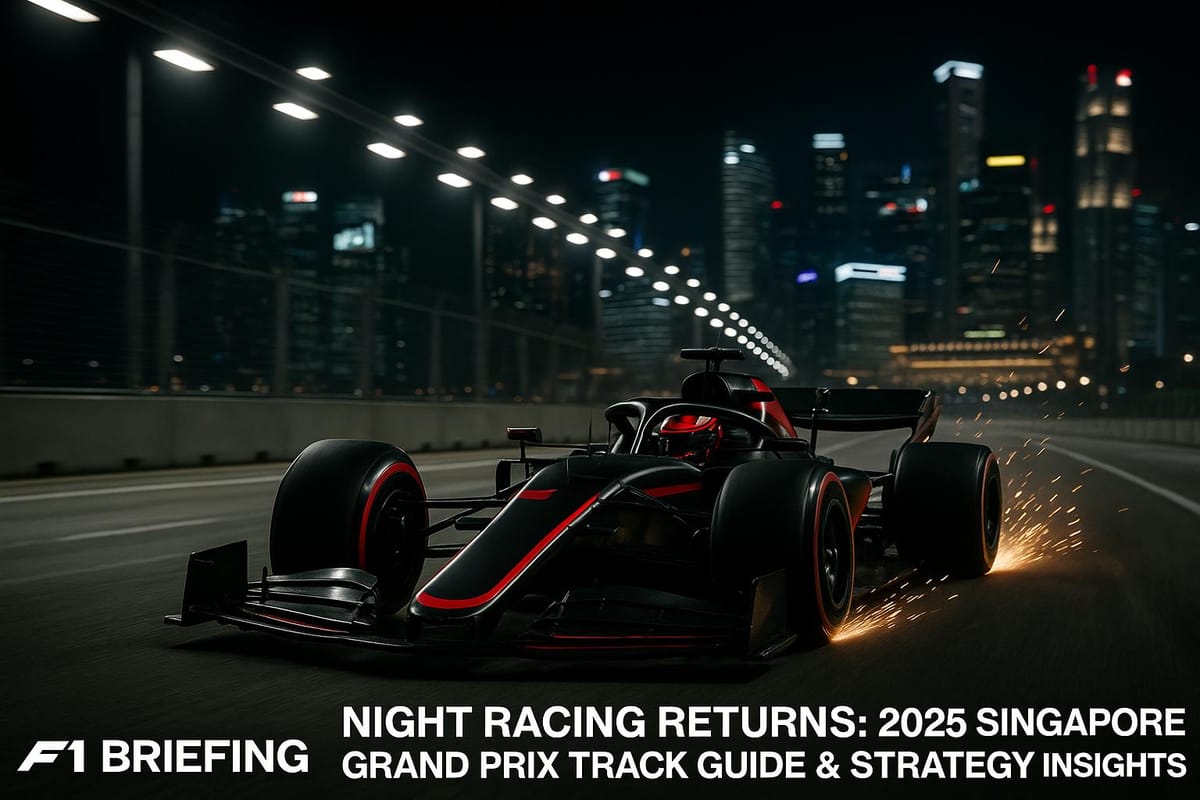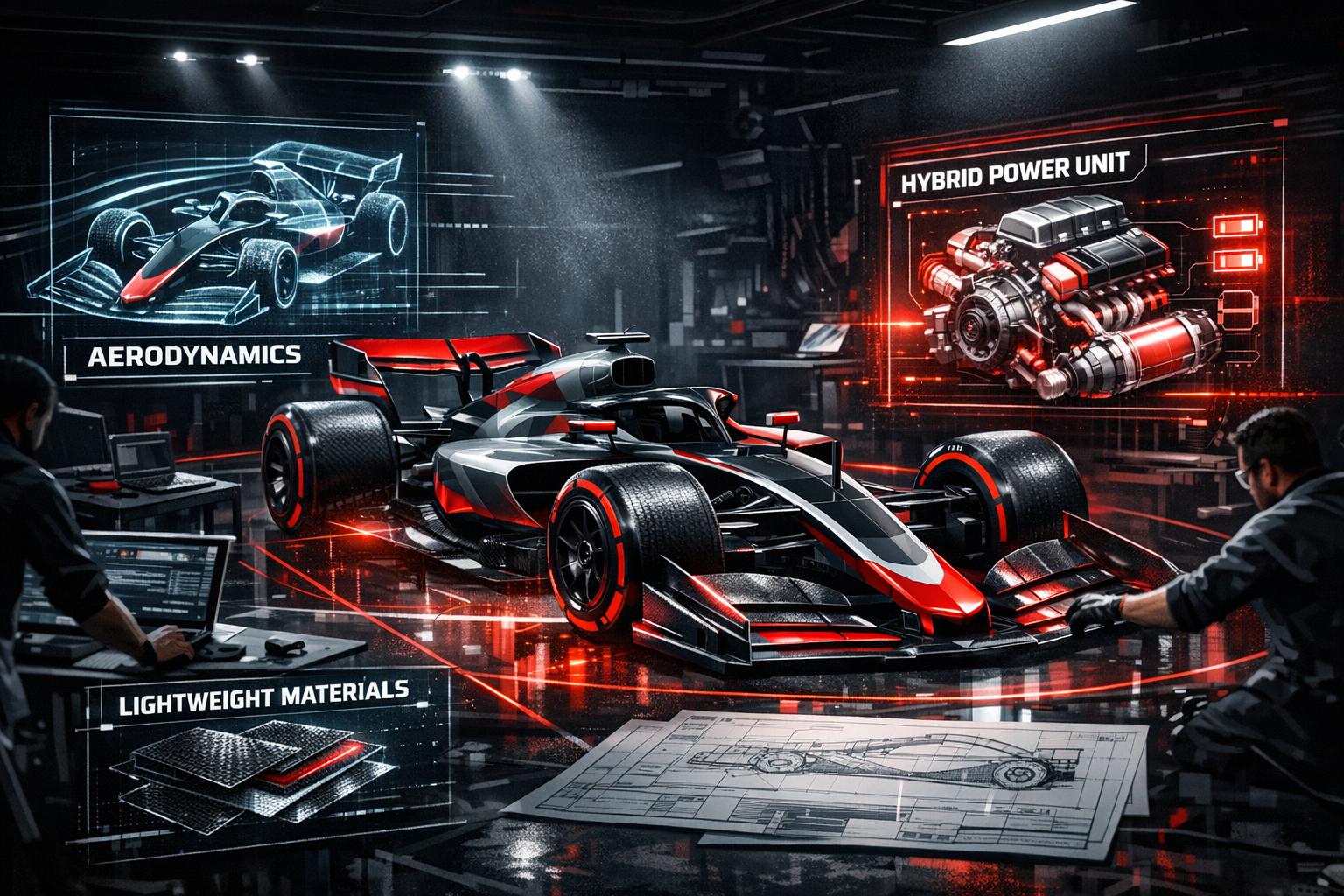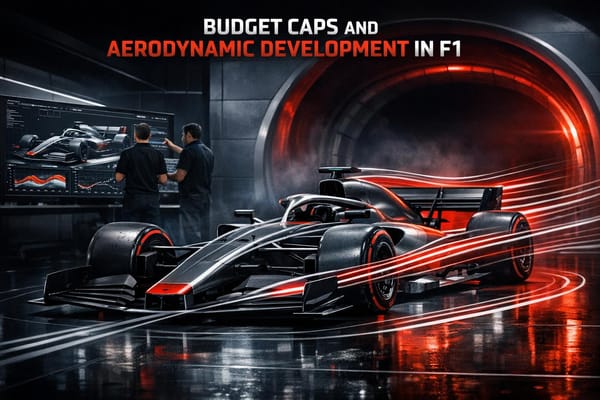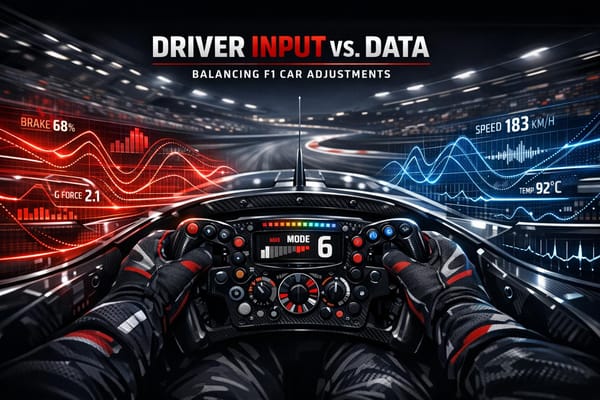Night Racing Returns: 2025 Singapore Grand Prix Track Guide & Strategy Insights
Explore the challenges and strategies of the 2025 Singapore Grand Prix, including track layout, tire management, and night racing conditions.

The 2025 Singapore Grand Prix at Marina Bay is one of the toughest Formula 1 races, testing drivers with extreme heat, humidity, and a complex street circuit - all under dazzling night lights. This race demands physical endurance, precise car setups, and smart tire management to navigate its 19 corners and 3.07-mile layout.
Key takeaways:
- Conditions: Tropical heat (~88°F) and cockpit temperatures up to 140°F challenge drivers, leading to dehydration (up to 6.6 lbs lost per race).
- Track updates: A 2023 redesign added a 1,305-ft straight, improving overtaking chances. Four DRS zones now aid speed battles.
- Pit strategies: Safety cars are almost guaranteed (24 deployments in 15 races), making pit timing crucial. A pit stop under safety car saves ~11 seconds.
- Tires: Pirelli's new C6 ultra-soft compound offers better grip for street circuits. Tire wear remains high due to sharp turns and bumpy surfaces.
- Driver focus: Success hinges on managing braking zones, avoiding crashes, and maintaining concentration through 62 grueling laps.
This is more than a race - it's a test of endurance, precision, and decision-making in one of Formula 1's most demanding events.
How to Master the Singapore GP! | Nico Rosberg | F1 Marina Bay Street Circuit
Marina Bay Street Circuit Overview
The Marina Bay Street Circuit stands out for its thrilling night races, weaving through the vibrant heart of Singapore's downtown. This temporary street track offers a mix of technical challenges and high-speed action, making it a favorite among fans and drivers alike. Let’s dive into its key specifications, layout changes, and the complexities of racing under the lights.
Circuit Facts and Specifications
Stretching 3.07 miles (4.94 km) per lap, the Marina Bay circuit covers a total race distance of 190.3 miles (306.143 km) over 62 laps. With its 19 turns, the track demands a blend of precision and speed, testing drivers with tight corners and rapid sections. Simulations using a 2020 Formula 1 car estimate a top qualifying lap time of around 1:27.7, with a full race taking at least 1:30:34.
Track Layout Changes Over Time
A major update came in 2023, tied to the redevelopment of The Float at Marina Bay into "NS Square". This redesign replaced turns 16–19 with a 1,305-foot (397.9 m) straight, now the circuit’s longest flat section. This change not only reshaped the track’s character but also opened up new possibilities for strategy and overtaking.
Night Racing Challenges
Racing at night on an urban circuit like Marina Bay brings its own set of hurdles. The artificial lighting, while spectacular, creates variations in visibility that impact driver depth perception and onboard cameras. Teams must fine-tune their car setups and adapt their strategies to account for these unique conditions, ensuring optimal performance under the glow of the city lights.
Track Analysis by Sector
The Marina Bay Street Circuit is divided into three distinct sectors, each designed to challenge both Formula 1 drivers and their cars in unique ways. To succeed under Singapore's demanding night race conditions, teams must understand these sectors inside and out, tailoring strategies to extract every ounce of performance.
Braking Zones and DRS Areas
Sector 1 kicks off with the circuit's most important overtaking opportunities. The main straight, starting at the finish line, features a DRS zone that lets drivers cut drag and gain speed advantages. Another DRS activation zone comes into play after Turn 5, setting up dramatic battles heading into Turn 7.
In Sector 3, the action heats up again with a critical braking zone at Turn 14. This corner often serves as the final realistic overtaking chance before the race transitions into the tight, technical closing section.
For the 2024 season, the FIA has introduced a fourth DRS zone, extending from Turn 14 to Turn 16. This addition transforms the kink-straight stretch into a high-speed overtaking possibility. However, the track’s bumpy surface and tricky cornering still demand precision and caution, even in these faster areas.
Dangerous Corners and Crash Zones
Marina Bay is notorious for its challenging layout. The bumpy surface along sections like Raffles Boulevard keeps drivers and engineers on edge, as these irregularities can destabilize cars at the worst moments.
The track’s history with safety cars underscores its difficulty. Across 15 races up to 2023, there have been 24 safety car deployments, with at least one appearing in every race until 2024. This consistency forces teams to remain flexible, constantly adapting strategies for potential interruptions.
The pit lane adds another layer of complexity. With a speed limit of just 37 mph (60 km/h), entering the pits requires precision, especially under night conditions where depth perception is compromised.
"Singapore is likely to be 'the most challenging weekend out of the upcoming races' given that 'the stakes are heightened on a street circuit and the field is usually very close, not to mention the heat and humidity.'"
– Max Verstappen
The physical toll on drivers is immense. Navigating the circuit’s demanding corners in Singapore’s heat and humidity can lead to extreme dehydration, with drivers losing up to 6.6 lbs (3 kg) during the race. This weight loss can impact reaction times and focus, especially in the toughest sections of the track.
Where Overtaking Happens
Despite the presence of four DRS zones, overtaking at Marina Bay remains a challenge due to the track's technical nature and the tendency for cars to run closely together. In 2023, only 85 overtakes were recorded, highlighting how difficult it is to execute clean passes here.
Turn 7 is the standout overtaking spot. The combination of DRS assistance and heavy braking creates the ideal conditions for drivers to make their move. The sharp deceleration here generates the speed differential needed for successful overtakes, making it a key area for strategic positioning.
"At the Marina Bay circuit we have often seen first stints where the drivers are trying to go as long as they can, managing their tires with the aim of balancing the two stints as much as possible. This often leads to the formation of a train of cars, all running nose to tail, unable to overtake because there is not enough of a performance difference, this despite the track having three DRS zones."
– Pirelli
Pit stops also play a major role in overtaking strategies. With a pit lane time loss of 29.83 seconds, teams often rely on undercut or overcut strategies to create the performance gaps needed for position changes. Tire management becomes a decisive factor here, as differences in tire wear and performance can open up opportunities during pit phases.
Former Renault driver Jolyon Palmer sums up the circuit’s complexity:
"Marina Bay is a long, complex circuit, and draining as well – a little bit like Monaco – with plenty of bumps. It's all about the low-speed and having decent turn-in without losing the rear or suffering snaps of oversteer."
– Jolyon Palmer
Tire Strategy and Pit Stops
Tire strategy plays a crucial role at Marina Bay. The unique demands of this street circuit - combined with night racing conditions and frequent safety car interruptions - create a complex puzzle for teams to solve over the nearly two-hour race.
Tire Compounds and Wear Patterns
For the 2025 season, Pirelli introduces six dry tire compounds (C1–C6), including the new C6 ultra-soft, specifically tailored for street circuits like Marina Bay. This expanded selection gives teams more strategic options, especially during qualifying sessions where maximum grip can make all the difference.
Marina Bay’s 19 corners are tough on tires, leading to noticeable wear patterns. The constant direction changes and sharp 90° turns create significant stress, while the abrasive street surface speeds up degradation. Soft tires, for instance, deliver peak performance for about 10 laps before wear becomes a factor. As a result, teams must carefully balance the need for speed in qualifying with the durability required for race day.
These wear dynamics directly influence decisions around pit stops and overall race strategy.
Undercut vs. Overcut Strategies
Tire management is central to pit stop strategies. At Marina Bay, the undercut strategy often proves effective due to the circuit’s overtaking challenges. A great example is the 2019 Singapore Grand Prix, where Sebastian Vettel gained a four-second advantage over Charles Leclerc and Lewis Hamilton by pitting early. After his stop, Vettel lapped four seconds faster than Leclerc, highlighting the power of fresh tires in such conditions.
Former Renault driver Jolyon Palmer explained, "The undercut is important at circuits where there is high degradation, track position is important and overtaking is difficult." On the other hand, the overcut - where a driver delays their pit stop to gain an advantage - has become rare in modern Formula 1. With rapid tire degradation, fresh rubber often outweighs any potential benefits of staying out longer.
Safety car deployments add another layer of complexity. Since the Singapore Grand Prix’s inception, every race has featured at least one safety car period. Pitting under these conditions can save up to 11 seconds compared to a standard stop, forcing teams to remain flexible and ready to adjust their plans in response to race developments or competitors’ moves.
Timing these pit stops effectively can make or break a race strategy.
Managing Tire Performance at Night
Night racing at Marina Bay introduces unique challenges for tire performance. Cooler evening temperatures slow down the process of bringing tires up to their optimal operating range, which impacts both qualifying and race strategies. Combined with the circuit’s high heat, intense humidity, and physically demanding layout of 19 tight corners, Singapore consistently ranks as one of the most grueling races on the Formula 1 calendar.
To counter these challenges, teams often start the race on medium-compound tires. This choice provides greater flexibility, allowing them to extend stints while staying prepared for safety car periods or reacting to rivals’ strategies. The key lies in striking the right balance between maintaining pace and preserving tire life over the course of the race.
Weather and Safety Car Effects
Singapore's tropical climate and the demanding Marina Bay circuit create a unique challenge for teams during the night race. It's not just about handling the physical toll on the drivers; teams also have to navigate unpredictable weather and frequent safety car interruptions. Let’s break down how these factors shape race strategies.
Singapore Weather Patterns
Singapore’s weather is a wild card. The high humidity and sudden rainstorms can turn a race on its head. Inside the cockpit, temperatures can soar to a scorching 122–140°F (50–60°C), pushing drivers to their physical limits. It's so intense that drivers can lose between 4.4 and 6.6 pounds during the race. Staying hydrated and physically prepared is non-negotiable.
Rain adds another layer of complexity. Tropical downpours reduce grip and traction, making accidents more likely. Visibility becomes a major issue, requiring drivers to use water-resistant visors and special helmet coatings. Teams keep a close eye on weather updates because choosing the wrong tires in wet conditions can cost up to ten seconds per lap. These weather challenges often lead to safety car periods, making race strategies even trickier.
Safety Car Frequency and Impact
Since the circuit’s debut (excluding 2024), its tight, twisty layout and unforgiving proximity to walls have made safety car periods a near certainty. These interruptions force teams to stay flexible and ready to adapt.
Peter Hall, AMF1's Head of Race Strategy, highlights the dual nature of these conditions:
"Wet weather gives us the biggest challenge, but these conditions also frequently provide the most exciting races."
One infamous example of the safety car’s impact occurred during the 2008 Singapore Grand Prix. Renault orchestrated a deliberate crash by Nelson Piquet Jr., knowing the resulting safety car would benefit Fernando Alonso. This race, like many others in Singapore, cemented its reputation as one of the most grueling on the Formula 1 calendar. The constant threat of neutralizations means teams must make split-second tactical decisions.
Adapting Strategy for Weather and Safety Cars
With unpredictable weather and frequent safety car deployments, teams need to be agile. A common approach is the "split strategy", where one driver pits while the other stays out, covering multiple scenarios. Advanced weather models help teams simulate various conditions and fine-tune their plans. Real-time communication between race engineers and drivers is critical for making informed decisions about tire changes and setup adjustments.
Peter Hall underscores the cost of tire mismanagement:
"Being on the wrong tire in wet conditions can cost as much as ten seconds."
Car setups also play a big role. Teams may adjust wing angles to increase downforce in wet conditions, while drivers adapt their techniques to avoid sudden moves that could lead to slides. Timing tire changes is another strategic gamble. Teams often delay pit stops during high-risk periods, aiming to take advantage of safety car neutralizations that save precious seconds.
Mario Isola, Pirelli’s Head of F1, sums it up perfectly:
"Neutralisations and the weather are two other unknown factors that definitely have to be taken into consideration, but there is little one can do about those, apart from being ready to make the most of any opportunity that presents itself."
Team Setup and Driver Tactics
In Singapore, preparing for the relentless challenges of the Marina Bay Circuit requires both carefully tuned car setups and seamless driver coordination. With its 19 corners packed into a 3.07-mile layout and cockpit temperatures soaring to a grueling 140°F (60°C), teams must strike a balance between technical precision and on-track execution to navigate this demanding night race.
Car Setup for Marina Bay
The Marina Bay Circuit demands maximum downforce, making it essential for teams to fine-tune both front and rear wing angles. This approach ensures the grip needed to tackle the circuit's many slow and medium-speed corners. While the setup philosophy is comparable to other street circuits like Monaco and Hungary, Singapore’s wider sections require additional adjustments similar to those used in Baku.
To enhance traction out of slower corners and minimize tire wear, teams reduce on-throttle differential settings. This is especially important given the circuit's heavy braking zones - drivers rely on the brakes around 15 times per lap, with the braking system enduring nearly 70 tons of total load over the course of the race.
Suspension tuning is another key element. Softer suspensions help absorb impacts from the circuit’s kerbs but can compromise cornering speed. Teams spend practice sessions experimenting with setups to find the optimal balance that allows drivers to ride kerbs aggressively without sacrificing lap times.
Tire pressure management takes center stage in Singapore’s sweltering conditions. To combat overheating in high-traction zones, many teams opt for lower rear tire pressures. Although the night race format helps cool the track and somewhat reduces tire degradation compared to daytime events, the combination of high humidity and elevated ambient temperatures still pushes tire performance to its limits.
Brake bias adjustments are equally critical. Fine-tuning the brake balance helps drivers navigate tight corners without locking the front wheels. Add to that the 62 gear changes per lap - the second highest on the F1 calendar - and it becomes clear how much stress Singapore places on both drivers and mechanical components. A well-optimized car setup is just the starting point; precise coordination between drivers and teams is what truly makes the difference.
Driver Coordination and Team Orders
The intricate layout of the Singapore Grand Prix circuit amplifies the need for flawless driver coordination. Teams often rely on strategic communication and team orders to maximize their points haul, especially when championship standings are on the line.
Over the years, team orders have played pivotal roles in race outcomes. For instance, during the 2019 Chinese Grand Prix, Ferrari instructed Charles Leclerc to let Sebastian Vettel pass, a decision Leclerc later acknowledged as being in the team's best interest. Similarly, at the 2022 Spanish Grand Prix, Red Bull directed Sergio Pérez to relinquish his lead to Max Verstappen.
To issue such orders discreetly, teams often use coded messages. Rob Smedley, a former race engineer for Felipe Massa, famously delivered the line:
"Fernando [Alonso] is faster than you. Can you confirm you understand that message?"
In a race like Singapore, where overtaking opportunities are limited and track position is crucial, these communications can make or break a team’s strategy.
The FIA’s Driving Standards Guidelines further emphasize the importance of fair yet strategic racing. The rules state:
"More than one change of direction to defend a position is not permitted"
On Singapore’s narrow straights, adhering to this rule becomes even more critical. Effective coordination and disciplined driving are essential for teams looking to thrive under the intense demands of Marina Bay.
Team Performance Comparison
Success at Marina Bay depends on how well teams adapt their strategies to the circuit’s unique challenges. By blending technical expertise with quick, decisive adjustments, teams can rise to the occasion and conquer this unforgiving track.
Conclusion
The Singapore Grand Prix is a true test of endurance, strategy, and precision, pushing teams and drivers to their limits. Success at Marina Bay demands excellence in three critical areas: technical preparation, strategic adaptability, and physical resilience.
To perform well, teams must nail the car setup while drivers endure grueling physical challenges. During the race, drivers can lose up to 6.6 pounds due to the intense conditions. The circuit's tight corners and demanding layout require a focus on medium-speed cornering, acceleration, and maximizing downforce. These physical and technical challenges make strategic precision non-negotiable.
Former Renault F1 driver Jolyon Palmer highlights the unique demands of the Singapore Grand Prix:
"A huge amount of concentration is required for this circuit and Grand Prix. You can lose a few kilos of liquid during the race, so hydration is the order of the day. Monaco might be the only venue with a slower average speed, but Singapore can be an absolute slog."
Flexibility in strategy is just as important. With a 100% chance of safety car deployment and unpredictable weather, teams need to adjust on the fly. A standard pit stop takes around 28 seconds, but under safety car conditions, that time drops to about 15 seconds. Weather adds another layer of complexity, as Peter Hall, AMF1 Head of Race Strategy, explains:
"Being on the wrong tyre for the conditions can cost as much as 10 seconds – or, in extreme cases, even more."
Tire management is another critical factor. The circuit’s humidity and high thermal stress force teams to carefully balance aggressive pacing with tire preservation. These conditions make one-stop strategies appealing but incredibly challenging to execute effectively.
Ultimately, success at the Marina Bay Street Circuit comes down to the perfect blend of preparation and in-race adaptability. Teams that excel in analyzing real-time data, adapting to evolving conditions, and supporting drivers through extreme physical demands will have the best shot at conquering this formidable race.
FAQs
How will the 2023 Marina Bay track changes affect overtaking strategies for the 2025 Singapore Grand Prix?
The 2023 redesign of the Marina Bay Circuit brought some notable updates, including the removal of the float section and the addition of a high-speed straight. These changes shortened the track from 5.063 km (3.146 miles) to 4.928 km (3.062 miles), increasing the lap count to 62. A new DRS zone was also introduced between Turns 14 and 16, aimed at creating more overtaking opportunities.
This updated section gives drivers the chance to carry more speed into overtaking moves, adding a new layer of excitement to race strategies. With the faster layout and the added DRS zone, teams are likely to focus on straight-line speed and tire management to make the most of these improved passing chances in 2025.
What challenges do drivers face during the Singapore Grand Prix night race, and how do teams prepare for them?
Drivers face a unique set of challenges during the Singapore Grand Prix night race. The combination of intense humidity and heat creates tough conditions, often pushing temperatures above 85°F. These factors accelerate tire wear, making tire management a crucial part of race strategy. The grueling nature of the track further tests drivers' physical endurance, demanding peak performance from start to finish.
The artificial lighting on the Marina Bay Street Circuit adds another layer of complexity. Shadows and bright lights force drivers to adjust their visual focus and maintain pinpoint precision under tricky conditions. To tackle these obstacles, teams carefully choose tire compounds that perform well in humid environments, fine-tune car setups to handle the tight, twisty layout, and plan pit stops strategically to keep tire wear under control. Preparation is key, with teams relying on detailed simulations and rigorous driver training to master the unique demands of this night race.
How do safety cars impact pit stop strategies and race results at the Marina Bay Circuit?
Safety cars play an important role in shaping pit stop strategies and influencing race outcomes at the Marina Bay Circuit. When the safety car is deployed, teams often seize the opportunity to make pit stops while the cars are running at reduced speeds. This strategy can save drivers around 29 seconds - a huge advantage on a track where overtaking is notoriously challenging.
Beyond pit stops, safety car periods can also shake up the race dynamics. They bunch up the field, erasing gaps between cars and opening the door for overtaking and position changes. Teams often use this time to rethink their tire strategies, whether it’s to stretch a stint or preserve tire life, depending on the remaining race distance. These moments tend to favor drivers and teams who can think on their feet, making the safety car a real wildcard in determining the final race standings.
Related posts
- Track by Track: The Complete Story of the 2025 Formula 1 Calendar
- Marina Bay Circuit: The Origins and Evolution of Singapore’s Iconic Night Grand Prix
- Las Vegas Strip Circuit: Glitz, Speed, and Strategy in the Heart of Sin City
- Night Speed in Jeddah: F1’s Fastest Street Race at the 2025 Saudi Arabian Grand Prix




